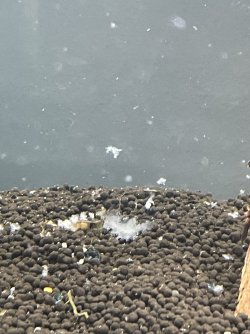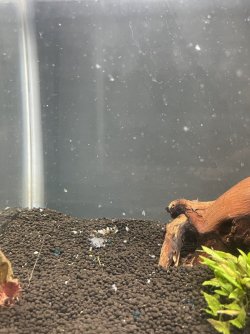There is often a difference in what we think is happening on the mcrscopic level in our tanks and what is actually happening.
Unless one has a lab setting and some expensive equipment, cycling is a bit of a "crap shoot." The reason for this is we lack accurate information on some of the important water parameters or which type of bacteria may be in the water or air to seed our initial cycing. And even if we did know the straains, we would have no way to know how much of anything with which we are starting. The statement by 10 tanks about Cycle is not the case, sorry buddy. What appears below will explain it, or at least the science behind it.
10 Tanks. you can make me look pretty silly if you can find any research in the past decade or so which shows that the bacteria in FW aquariums which process nitrite to nitrate or ammonia straight to nitrite, and which will presist there over time, that are Nitrobacter starins. At the end of this post are several studies that are relevant here.
SO, all we are able to do is to measure a few of the relevant parameters with our hobby test kits. This means we really have no clue, day to day. What we can see is when we reach the range of results where we know things have happened and then what needs to happen next.
What happens when one chooses to use Cycle with the Nitrobacter instead of having Nitrospria? The first part is easy to grasp. Nitrobacter thrives on much higher concentrations of Nitrite than do Nitrospira. Which strain will dominate depends on how much nitrite is available (this depends on how much ammonia as well).
So, when we cycle whether with fish or fishlessly, ammonia builds up to a level it will normally never hit in an established tank. The problems happen if ammonia or nitrite gets too high. This effectively discourages the colonization of the baceria we ultimately have and encourages those that will not persist. If we add Nitrobacter, they are working on a nitrite situation that won't last very long. And, as the concentrations start to drop, those initial bacteria start to die off and to be replaced by the ones which can thrive in an aquarium. As a cycle progresss the concentration of excess ammonia or nitrite in the water drops. It eventually becomes low enough that it cannot support a thriving colony of Nitrobacter. Which is why they are generally gone and have been replaced by the Nitrospira.
So, in the end no matter what starter bacterial strains we have in a tank, the ones that will be there are the ones that should be and not those that cannot thrive there. The Nitrobacter in Cycle vanishes to be replaced by the Nitrospira. But, it appear to us as if the Cycle did the job. It is my feeling that cycle just delayed the result and one could have cycled faster and cheaper using something elese. Dr. Tim's is more money than Cycle because it contains the "right stuff."
But I hate to pay up so I do things a bit differently. I start with about half of the bacteria I need using Dr. Tim's product. Then I use cheap ammonium chloride to make the bacteria reproduce. I know under optimal conditions this would happen in well under 24 hours except that the bacteria in the bottle are dormant goin into the tank. They need ammonia to wake them up and go back to work. This can be a matter of hours but could not be more than a day. So, after I add the 1/2 bacteria dose into a tank with ammonia, I expect to be able to add a full fish load in anywhere from 1 to 3 days.
The way I know the tank is ready is simple. I add 2-3 ppm of Total Ammonia to the tank. If I can test 0/0 for ammonia and nitrite in 24 hours or less, the tank is cycled. I add the bacteria once. I keep the temp near 80F, or a tad higer, and I make sure that the KH of the tank reads several degrees the whole time.The bacteria take a lot of the inorganic carbon the need from the carbonates and bicarbonates that pretty much make up KH in our tanks. So I may add a bag of crushed coral to help hold up the KH.
Blackburne, R., Vadivelu, V.M., Yuan, Z. and Keller, J., 2007. Kinetic characterisation of an enriched Nitrospira culture with comparison to Nitrobacter.
Water research,
41(14), pp.3033-3042.
https://www.sciencedirect.com/science/article/abs/pii/S0043135407000826
Abstract
Nitrospira and
Nitrobacter are nitrite-oxidising bacteria commonly identified in nitrogen removal
wastewater treatment plants. Little is known about the growth parameters of
Nitrospira or the effects of environmental conditions or inhibitory compounds on
Nitrospira activity. These bacterial properties were investigated using an enriched
Nitrospira culture and an enriched
Nitrobacter culture or
Nitrobacter literature values. Compared to
Nitrobacter,
Nitrospira was found to have a comparable optimal pH range (8.0–8.3); similar normalised activity–temperature relationship (0.44e0.055(
T–15)) for temperatures between 15 and 30 °C and a similar oxygen half-saturation constant,
KO (0.54±0.14 mg L−1). The major differences identified were that
Nitrospira had a lower nitrite half-saturation constant,
KS (0.9±0.07 mg NO2-N L−1); lower inhibition threshold concentrations for free ammonia (between 0.04 and 0.08 mg NH3-N L−1) and free
nitrous acid (less than 0.03 mg HNO2-N L−1) and a higher yield (0.15±0.04 g VSS g N−1). Therefore,
Nitrospira is more likely to dominate nitrite oxidation under conditions with low ammonium and nitrite concentrations, which would provide an advantage to them due to their lower
KS value while avoiding any free ammonia or free nitrous acid inhibition.
Nowka, B., Daims, H. and Spieck, E., 2015. Comparison of oxidation kinetics of nitrite-oxidizing bacteria: nitrite availability as a key factor in niche differentiation.
Applied and environmental microbiology,
81(2), pp.745-753.
https://journals.asm.org/doi/full/10.1128/aem.02734-14
ABSTRACT
Nitrification has an immense impact on nitrogen cycling in natural ecosystems and in wastewater treatment plants. Mathematical models function as tools to capture the complexity of these biological systems, but kinetic parameters especially of nitrite-oxidizing bacteria (NOB) are lacking because of a limited number of pure cultures until recently. In this study, we compared the nitrite oxidation kinetics of six pure cultures and one enrichment culture representing three genera of NOB (Nitrobacter, Nitrospira, Nitrotoga). With half-saturation constants (
Km ) between 9 and 27 μM nitrite, Nitrospira bacteria are adapted to live under significant substrate limitation. Nitrobacter showed a wide range of lower substrate affinities, with
Km values between 49 and 544 μM nitrite. However, the advantage of Nitrobacter emerged under excess nitrite supply, sustaining high maximum specific activities (
V max) of 64 to 164 μmol nitrite/mg protein/h, contrary to the lower activities of Nitrospira of 18 to 48 μmol nitrite/mg protein/h. The
V max (26 μmol nitrite/mg protein/h) and
Km (58 μM nitrite) of “Candidatus Nitrotoga arctica” measured at a low temperature of 17°C suggest that Nitrotoga can advantageously compete with other NOB, especially in cold habitats. The kinetic parameters determined represent improved basis values for nitrifying models and will support predictions of community structure and nitrification rates in natural and engineered ecosystems.
edited for typo



